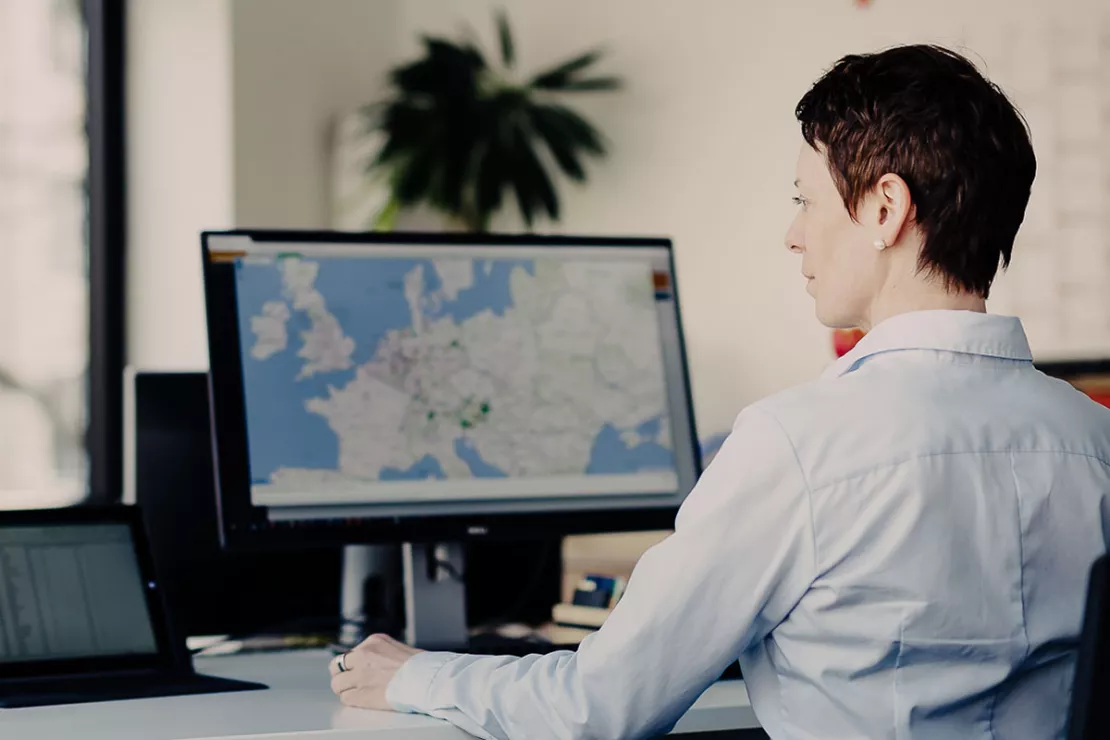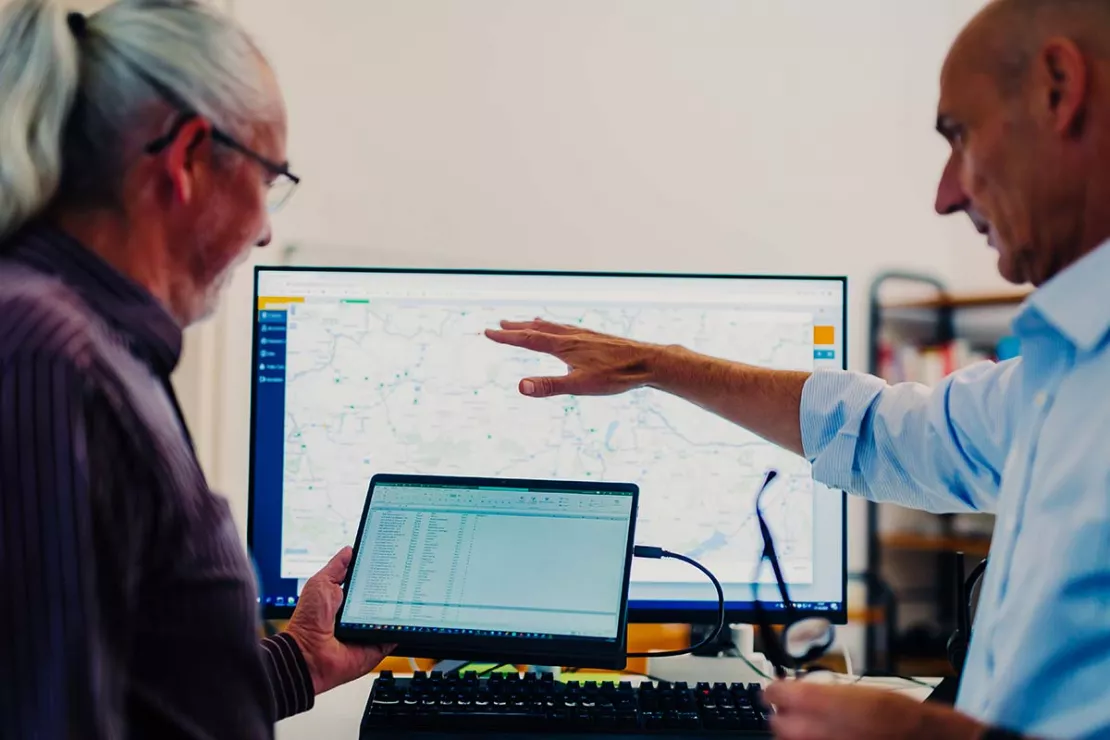Geocoding in Focus: Experts on Trends and the Latest Features in Geocoder JoinAddress 5.0
In modern data analysis, geocoding is becoming increasingly important for companies. This technology enables companies to add geographic coordinates to customer data and thereby gain valuable insights into spatial patterns and relationships.
WIGeoGIS Experts Discuss the Current Role of Geocoding and What a Modern Geocoder Should Offer
WIGeoGIS has been working and developing geocoding solutions for companies for over 30 years. The latest version of the Geocoder JoinAddress is now available.
The experts Renate Dumberger, Senior Manager at WIGeoGIS, and Harald Meier, Software Engineer at WIGeoGIS, join us to talk about the advantages of geocoding, its role in modern data analysis and why the Geocoder JoinAddress 5.0 is now even better.
Basics: How a Geocoder Works
A geocoder consists of two main components:
- A software that can assign an X and Y coordinate to each address.
- A reference database that contains addresses and coordinates.
The software accesses reference databases to make a comparison and locate the address correctly on the map.

Try the Geocoder JoinAddress now for free and with no obligation. Geocode 400 worldwide addresses!
Why is geocoding important for modern data analysis?
Renate Dumberger: Data analysis, especially the analysis of customer data within databases, offers many opportunities to analyze characteristics such as purchasing behavior. However, it is important to also consider the data in a spatial context, as this provides additional insight that is not available without a spatial reference. This is where geocoding comes into play: Customer addresses are given X and Y coordinates in order to display them on a digital map. This type of address geocoding allows you to locate a point on the map complete with all the details such as the street name, house number, ZIP Code and city. However, geocoding can also use the ZIP Code structure to aggregate customer data and represent spatial structures such as customer density or market penetration.
How has the use of geocoders changed in recent years?
Renate Dumberger: In recent years, companies have become more and more aware of the significant benefits geocoding has to offer. This can be explained quite well by taking a look at the retail and insurance industries for example. Retail chain stores need exact location data for expansion planning, while insurance companies rely on accurate geocoding to help assess properties in terms of flood risk for example.

Modern data analysis means also looking at data in a spatial context. This provides additional insight that is not available without a spatial reference. This is where geocoding comes into play: Customer addresses are given X and Y coordinates in order to display them on a digital map.
Renate Dumberger, Senior Manager, WIGeoGIS Munich
Register for free. Test our geocoder with 400 addresses for free!
How have geocoding tools evolved recently, especially JoinAddress?
Harald Meier: We have significantly expanded and updated the reference databases for JoinAddress with data from TomTom and other reliable data. This means we can guarantee almost 100% coverage in around 61 countries. This is especially important for companies that expect highly accurate and up-to-date data. We have also made technical optimizations to JoinAddress that improve the security and performance of the geocoding processes. On top of that, we also integrated AI functions.
To what extent does artificial intelligence play a role in the Geocoder JoinAddress?
Harald Meier: We use AI methods for address processing. We see particular potential in the use of artificial intelligence in geocoding systems to better process and analyze unstructured address data. This contributes to even better geocoding results and also helps with address validation, another very important area in which our customers rely on geocoding.

The geocoding accuracy of JoinAddress was already so good that there was little need for optimization here. Therefore, in the latest version we first focused on expanding the reference database. This means we can now geocode 61 countries comprehensively. Secondly, we have integrated AI methods to better process unstructured data more quickly. Lastly, we have improved the security and performance of the geocoding processes.
Harald Meier, Software Engineer, WIGeoGIS Vienna
Is it correct that in addition to locating addresses on the map, companies also use JoinAddress for address validation? What does that process look like?
Harald Meier: Yes, many of our customers also use JoinAddress for address validation. This simply means that they check the address records for correctness and completeness. This is especially important for postal mailings and marketing campaigns. We use official reference addresses to check the addresses and detect possible discrepancies. For example, an incomplete address can be corrected, which significantly improves delivery accuracy.
How do you know that JoinAddress geocodes and validates addresses correctly?
Harald Meier: In contrast to geocoding solutions from other, sometimes very prominent providers, the Geocoder JoinAddress is not a black box. Our customers can follow the geocoding steps and thus better understand and interpret the results. This transparency is what sets our geocoder apart. You know exactly what happens, when and where, with the data.
Is JoinAddress also suitable for geocoding highly sensitive data?
Renate Dumberger: Yes, definitely. The majority of our customers who use JoinAddress work with highly sensitive data. These include well-known companies from the insurance industry and the banking sector in German-speaking countries. We offer in-house installations, which is particularly important for data protection-sensitive industries. There is also the option of cloud-based online geocoding, with the data hosted on our own WIGeoGIS servers within the EU, ensuring that all European data protection requirements are met.
With JoinAddress you can geocode securely and precisely on servers in the EU in compliance with data protection regulations. Try it now for free with no obligation!

Spot Light: Case Studies and Examples?
Let's talk about specific areas of application and best practice examples.
What experience does WIGeoGIS have here as a provider with almost 30 years of expertise in the field of geocoding?
How does geocoding help, for example, retail, the insurance industry, healthcare and authorities such as police, fire departments and rescue services?
Retail
Renate Dumberger: For retail chain stores, precise location analysis is crucial. For example, let’s take a large supermarket chain that uses JoinAddress to optimize the distribution of its stores and plan new locations. By geocoding their customer addresses, the company was able to find out where potential customers live and launched targeted marketing campaigns accordingly. This led to a significant increase in sales in newly developed areas.
Insurance Industry
Renate Dumberger: Another example is the reinsurance industry. Munich Re uses JoinAddress to precisely assess risks. In the event of natural disasters, such as floods or hailstorms, they can determine exactly which houses are affected and make the appropriate claims settlements. Precise geocoding helps to better calculate insurance premiums.
Healthcare
Harald Meier: In healthcare, organizations use JoinAddress to improve care in rural areas. One example is a state health department that analyzed the availability of general practitioners and specialty clinics in rural areas. By geocoding the population and medical facilities, the state health department was able to develop more efficient medical care plans and improve patient accessibility.
Authorities such as Police Departments, Fire Departments and Rescue Services
Renate Dumberger: The police also use geocoding, for example to locate accident black spots and crimes. These do not always occur at a precise postal address, but also happen, for example, on the motorway or in parking garages, and also have to be located exactly. There are special systems that allow the location to be determined precisely. Geocoding also plays an important role for rescue services and fire departments. The emergency services require very precise reference data, ideally based on GPS-accurate coordinates, in order to locate the sites of emergencies such as fires or accidents quickly and accurately, even if they are in remote locations. Using addresses is just the basic approach. There are a variety of positioning methods that are tailored to specific needs, such as those of police or emergency services.
Renate Dumberger and Harald Meier, thank you very much for the interesting conversation.
JoinAddress: Fill out the form, test it free of charge & without obligation!
- Non-binding, free test*
- Test ends automatically without cancellation
- Geocode 400 addresses for free
* The products of WIGeoGIS are intended for companies and are not suitable for private use. If you need a one-time market analysis, we will gladly make you a service offer.

